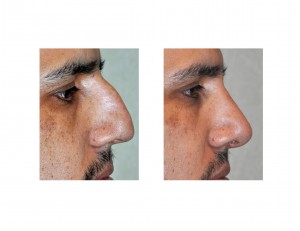Background: Rhinoplasty involves potential manipulation of all components of the nose. One of the most common areas of change is of the hump or bump on the nose. While frequently though of as just, the nasal hump is actually a combination of bone and cartilage and the highest peak of the hump often represents where the two meet. The larger the nasal hump is, the more significant the bony part of it is.

The position of the radix can have a great impact on how the nose looks. What it affects most is the appearance of nasal length. Since the radix marks the beginning of the upper dorsum of the nose, it directly influences nasal length. A high radix creates the impression of greater nasal length. A low radix decreases nasal length and makes the nose look shorter.
In large nasal humps, the nose appears quite top-heavy. The radix is way overprojected and the nasofrontal angle is wide open. The bone of the upper nose (bony vault) is overgrown. This draws the eye to the nasal bridge and make the nose look big.
Case Study: This 35 year-old male wanted a rhinoplasty to make his nose look smaller. He had a fairly straight nose but with a very large dorsal hump and a high nasion. The radix was almost at the level of the lower end of the eyebrow.

His nasal splint was removed one week later. By three months after surgery, the final shape of the nasal bridge and dorsal profile were seen. Besides a straight dorsal line, the position of the radix has been lowered as well.

Case Highlights:
1) Noses with large dorsal humps often have a high radix or protruding nasofrontal junction.
2) Large nasal hump reductions in rhinoplasties may require a percutaneous osteotomy technique to adequately reduce a high radix.
3) An appropriately placed radix enhances the effects of a straight dorsal line for a more pleasing rhinoplasty result.
Dr. Barry Eppley
Indianapolis, Indiana


